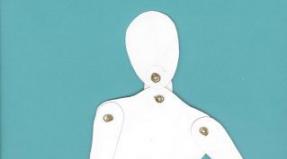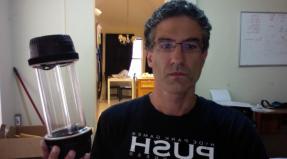How to wear a cap. How to fit a mouthguard to your teeth. Ready and customized
Athletes who are faced with the need to use for the first time often wonder how to cook it correctly?
What you need to know before you cook kapa
A mouthguard protects the athlete's teeth and jaw from possible injuries that cannot be avoided in contact sports. Mouthguards happen various kinds:
* some have a rigid construction specified by the manufacturer;
*others may take custom shape.
Since the former do not sufficiently protect the oral cavity, it is recommended for athletes practicing martial arts to use flexible mouthguards. They are being processed elevated temperatures take the form of a jaw.
What to prepare before cooking kapa
You need to start by reading the instructions. The materials and manufacturing technology of caps differ from manufacturer to manufacturer, so the time of direct cooking can vary from 8 to 30 seconds. Do not exceed the processing time, if it is indicated in the description. Otherwise, the cap material will be hopelessly damaged, and it will not be possible to use it for its intended purpose. When the cooking time is not indicated in the description, in any case, you should not wait more than 30 seconds.
For the cooking process itself, you will need two containers, one for cold water, the second for boiling water. You can prepare any tongs or a similar tool - this will make it easier for you to remove the mouthguard from boiling water.
Directly on how to cook capa
You will need boiling water, so do not fill the container with water beforehand. Put the mouth guard in boiling water so that it is covered with water for the time indicated in the manufacturer's instructions, or for 30 seconds if the time is not indicated. After the specified time her must be placed in the mouth and tightly but carefully squeeze the mouth so as not to bite through it. Your task at this stage is to make the most accurate cast of the jaw as possible, for this you need to spread the mouth guard with your fingers and press it more tightly to your teeth. In this position, the cap must be left for 3-4 minutes, and then lowered into cold water so that it acquires hardness and "hardens".
The cap is ready for use, it remains to check whether the jaw print is so accurate, because your safety depends on it. It is very simple to do this: you need to put a mouthguard on your jaw, while you do not need to close your mouth, move your head sharply. If the mouth guard remains absolutely still, then everything is in order and it can be used. In addition, you can determine whether everything is done correctly by clicking on the place where the front teeth will be - the cap should not change its shape. Look also at the mouthguard itself - it should have a clear imprint of the teeth.
If you have come to the conclusion that you did not succeed in doing the right thing, you do not need to be upset. The mouthguard for teeth has good thermoplastic qualities, so you can repeat the cooking process until you achieve a result that suits you. Do not forget that the safety of your teeth depends on the correctness of the process.
A cap is a special protective device that is inserted into the mouth. The cap protects the athlete's jaws and teeth from damage. It is used in those sports where there is a high probability of damage to the oral cavity: boxing, hockey, American football and others like that. Mouthguards are sold in sports stores, but they are all standard there. In order for the mouthguard to fit comfortably in the mouth, it must be adjusted to the structure of the jaw and teeth. There is even the term "cook kapu", i.e. treat it with hot water so that it softens and takes the desired shape.
Mouth guards are single-jawed (only on the upper jaw) and double-jawed (on both jaws, with a breathing hole). Buy a mouthguard only from a trusted brand and one that is designed for a particular sport. The most comfortable is considered to be a mouthguard of medium hardness. Check it out in the store by bending it a little with your hands. Discard very soft or, conversely, too hard. Cooked mouthguard, which is called thermoplastic. It softens easily in hot water, and then just as easily cools and retains the desired shape. To prepare the mouthguard, prepare a kettle of water and a deep bowl large enough to fit the guard completely. Before cooking, read the instructions, which says how long you need to keep the mouthguard in boiling water. Now weld the burl like this:- Boil water and pour it into a bowl.
- Put a mouthguard in hot water and keep it there for as many seconds as it is written in the instructions.
- Remove the mouthguard from the water and insert it into your mouth.
- Press the mouth guard with your teeth so that it fits comfortably in your mouth.
- Press the mouthguard against your teeth with your fingers so that the inside of the mouthguard is as snug as possible against your teeth.
- Keep the mouthguard in your mouth for three to four minutes.
- Carefully remove the mouthguard and dip it in cold water to cool further.
- Remove the cap from the water after 10 minutes.
Sometimes it happens that the packaging does not indicate how much capa should be kept in boiling water. Then boil the cap for no more than 30 seconds - this is the standard time for softening the thermoplastic mass.


- after each use, wash with clean cool water;
- store in a special ventilated container;
- Do not expose to extreme heat or cold (sun or frost).
One mouth guard is recommended to be worn for no more than one sports season. Then you need to dispose of it and cook yourself a new cap. Protect your teeth and don't skimp on it. Indeed, due to carelessness or sudden movements, you can be left without them. In this case, going to the dentist will cost many times more than regular purchase and renewal of a mouthguard.
Dentistry, like all other branches of medicine, does not stand still and is constantly changing, adjusting to the needs of customers. IN last years the demand for procedures that improve the aesthetic component of the dentition has increased. But people do not just want a beautiful smile, they want to get it as quickly as possible and without any discomfort. Braces cannot be discounted, but there is an alternative that will suit many - a cap.
A cap is a removable silicone or plastic cover that is worn over the dentition. This design is usually almost invisible in the mouth, although due to the fact that there are no special fasteners, it may occasionally fall out.
One of the ways to make caps is very similar to the production of prostheses. Impressions are taken of all teeth, after which a 3D model is created based on the impressions. Often a series of virtual caps is created at once, with the help of which it will gradually be possible to achieve an ideal result, because each of the caps is designed only for intermediate alignment. Further, the virtual cap is made of acrylic or silicone. Since this is a removable design, it does not require installation in the dental office.
There is another cheaper one fast way make a cap. To do this, a little warm plastic is applied to the teeth, which freezes on the teeth for several minutes. In this way, a perfect impression is obtained, which is only slightly corrected and polished. However, this technique is now rarely used.
There are 2 main types of aligners for teeth alignment:
- For permanent wear;
- Night.
Since the mouthguards act very slowly, the night ones are used only to fix the result. In other cases, it is required to wear a mouthguard for at least 21 hours a day. It is worth noting that you can order a product for both one and two rows at the same time.

Cap benefits include:
- Stealth;
- Comfortable to wear and quick to get used to;
- Good adaptation of the mucosa to the structure does not cause speech defects even during the period of addiction (3-4 days);
- Possibility of simultaneous whitening of teeth or prevention of caries. However, at the same time, the cap itself is made only under healthy teeth or after the main stages of treatment;
- Having to take it off while eating does not make it difficult to eat.
Who is wearing it?
Mouthguards for aligning teeth as an alternative method to braces are not suitable for everyone. There are several options in which the dentist may recommend this exit:
- To fix the result of teeth alignment with braces. The fact is that teeth are quite mobile at any age. That is why even adults can correct an overbite. Braces straighten the teeth, change the direction of their growth, but there is a possibility that after removing this device, the jaw row will begin to shift again. Re-installation of braces is not carried out, as this is a radical method, so the doctor can give a recommendation to consolidate the effect. In this case, it is enough to wear a mouth guard for only a few hours a day or to install it at night. It is very convenient to whiten your teeth at the same time, since a special gel can be applied to the inner surface;
- To eliminate small defects in the dentition. As a rule, aligners cope well with problems such as crooked teeth or wide interdental gaps. In the latter case, for the period of wearing the cap, this defect will not even be noticeable, since it will be hidden by opaque acrylic. Although most of these designs are made of transparent silicone, you can choose colored plastic with a white tint;
- If you are allergic to metal. There are not so many people who suffer from metal allergies, but braces cause them extreme inconvenience: the constant contact of the metal arc with the mucous membrane leads to pain, irritation and even inflammation.

Caps can be worn at any age. They are even made for children to correct the bite of milk teeth, since braces are not put on them. At this age, the teeth are especially mobile, therefore, with the help of a silicone product, almost all problems of the dentition can be eliminated. Children's mouthguards do not need to be worn all day, it is enough to use it for several hours. Often the use of caps is combined with some speech exercises. Such gymnastics for the oral cavity in combination with a leveling structure has a beneficial effect on the position of the teeth, and is also the prevention of malocclusion when changing teeth.
Also, a mouth guard can be prescribed by a doctor for sleep problems. For example, at night a person grinds his teeth. With regular symptoms, this leads to crumbling of the teeth and their subsequent loss. However, the mouthguard prevents the teeth from touching, and therefore solves the dental problem before it occurs.
Capa is considered to be a kind of analogue of braces, however, a complete replacement of one design with another is out of the question. The fact is that the cap can only cope with small defects. Incorrect bite does not apply to those problems that are solved with the help of a mouth guard. Only in some cases, when the patient suffers from a metal allergy, a mouthguard that is changed every 1-3 weeks can somehow solve the problem.

The main problems in which the use of a mouth guard is indicated are defects in the dentition, which, although they affect the bite, are mainly not functional, but aesthetic. For example, if one tooth protrudes from another, a mouthguard is applied, but if the teeth in the entire row grow in the wrong direction, braces will be required.
Since in some cases, with an allergy to metal, silicone constructions are still used instead of braces, a cap can replace them to some extent. However, the leveling process will be very long, you will have to change a large number of caps. Sometimes the price of even one mouthguard for teeth alignment can exceed the cost of installing a bracket system, which means that a full course with the use of silicone structures will be quite expensive. This is another reason to refuse the use of caps for problems with bite.
How to wear?
When making a mouthguard, the dentist usually tells the client how long it will take to straighten the teeth. Usually mouthguards are worn for about 2 years, even if there was experience wearing braces before that. But only a professional can clearly answer this question after examining the oral cavity and creating a series of 3D models. After removing the braces, it is recommended to wear mouth guards for the first few months without removing them during the day, but when the risk of returning to the previous problem decreases, they can only be worn during the day.

If you remove the structure too often, you will notice that it has become tight to dress. This is the first sign of degradation that brings you back to the previous state of malocclusion. In such cases, you need to use the mouth guard for a longer amount of time, removing it only for cleaning and while eating.
Children's mouth guards are worn for short periods of time, but every day: from 30 minutes to 2-3 hours.
How to take care of your teeth and aligners?
Mouthguards are very unpretentious in care, mainly because they are removed at the time of eating. However, you still need to clean them every day, and preferably several times. It is enough to rinse the mouth guard under cool running water, however, after a night, due to plastic covers, there may be an unpleasant aftertaste in the mouth, so you can additionally clean the mouth guard with a toothbrush. To do this, it is better to use an old brush with soft bristles that will not scratch the surface. The hood needs to be cleaned inside and out. In order to remove the unpleasant aftertaste from bacteria accumulating inside, you can use toothpaste while cleaning the mouthguard.
Sometimes inside the cap is going white coating. In this case, dentists advise holding the structure in a special cleaning solution, then clean and rinse the mouthguard under water.
The cap is stored in a special case with holes for better ventilation. If you plan to eat out, then this box should be on hand to put a silicone product in it. It is best to rinse it before putting it back on again.

Dental care is carried out without changes. The mouthguard is removed for the duration of the cleaning and the mouth is cleaned with a brush and paste twice a day.
It is not allowed to chew while using the cap. chewing gum as it may damage or stick to the plastic. Also, you can’t smoke in mouthguards, because the mouthguards very quickly begin to change color and become cloudy. It is forbidden to influence the caps with hot temperatures: dry with a hairdryer, steam, cook, and so on. If you are not sure that the tray is perfectly clean, place it in an antibacterial solution recommended by the dentist, and then rinse with water. This will be enough.
If you use special gels for teeth whitening or caries prevention, after each removal it is necessary to rinse the mouthguard, removing the remnants of the product from it. You should also brush your teeth. The gel itself is applied in small portions to the inside of the cap. Additionally, it is not required to “smear” it, since it will be distributed in the process of wearing.
Useful article? Add to your bookmarks!
Cap - indispensable for contact and extreme sports, it is a reliable and time-tested protection for teeth and jaw.
A mouth guard is used in all sports where there is a possibility of injury to the face, injury prevention is always cheaper than treatment.
The cap not only protects against mechanical damage, but also softens the blow to the jaw, helping to avoid concussion.

Usually mouthguards are double-sided, for both jaws and one-sided for the upper jaw.
It is believed that one-sided mouthguards are more comfortable, because breathing in a two-sided mouthguard is noticeably harder. On the other hand, moderate hypoxia produces additional endurance.
Mouthguards are divided into plastic, thermoplastic anddental.
Plastic (molded) mouthguards are the cheapest, but such mouthguards do not fit well in the mouth and do not always protect against injury. For the best protection, a mouthguard should be made from an individual cast of teeth. It completely repeats the relief of the teeth and provides a perfect fit and maximum protection. Although, such a cap will cost more, but it will do its job much better. It is worth noting that not a single cap, even the most expensive and made according to special. ordering from a dentist does not give a 100% guarantee for the safety of your teeth.

Thermoplastic (individual) mouthguards:
The cap is made up of several layers of thermoplastic material. In this case, the teeth are closed and the lower jaw is in the correct position. More expensive models of such caps are three-layer in the frontal section and two-layer in the side. The construction of hard and soft layers, as well as the air gap, allow you to simultaneously contain and soften the blow. Orthopedic support mandible and a special shape of the cap, which has a thickening at the base, and a reinforcing insert gives additional strength and maximum protection to the front teeth and guarantees the optimal mutual position of the jaws and a reduction in the frequency of injuries.
Dental caps are made individually, according to casts of teeth, thanks to which they accurately repeat the shape and size of the teeth. This guarantees a perfect fit, good protection and no problems with breathing and speech, but the cost of dental caps starts around 6 thousand rubles for the base model. Such mouthguards are used only in professional sports, so if you are not going to fight for the title of world boxing champion in the near future, then the ideal choice is a good thermoplastic mouthguard, costing from 600 rubles.

Heat treatment of cap.
Before you figure it out how to cook kapa, let's clarify, regardless of the type of cap, the method how to cook- one, only time and temperature differ.
How to cook a regular mouthguard:
1. Boil water (without a cap) and prepare 2 vessels: empty and with cold water, pour the boiled water into an empty vessel.
2. Put the mouth guard in boiling water for 20 - 30 seconds(See instructions for cap for exact time)
rinse your mouth with cold water (so as not to burn your gums)
3. Remove the cap from boiling water and bite with your teeth. At the same time, draw air into yourself to press it harder to your teeth. Hold it like this for three to five minutes and lower the cap into cold water in order to "harden" the cast. In case of failure, you can always digest the mouthguard again.
How to brew a gel cap:

Result: after preparation, the imprints of all teeth will remain on the cap. The mouth guard should fit well on one upper jaw without the help of the lower.
How to care for a hood: After each use, the cap should be rinsed with running water. The mouthguard should be stored in a well-ventilated box. Do not expose the mouthguard to heat or direct sunlight. From time to time, the mouthguard should be brushed with a regular toothbrush for several minutes, just like teeth. Pour balm or rinse aid into the capa box, rinse it. These actions will help to keep the mouthguard for a long time and ensure the safety of the oral cavity from bacteria.
Many people not associated with contact species sports, they often wonder why a boxing mouth guard is needed at all and why is its use mandatory in professional and semi-professional arenas? Structurally, the mouth guard is a plastic device that anatomically repeats the shape of the human jaw (usually the upper jaw, although there are also double jaw variants).
A properly worn boxing mouthguard does not create any discomfort, and even more so - pain. In particular, thermoplastic mouthguards are used for this, which need to be “cooked” and “bited” while they are flexible, when such a mouthguard hardens, it takes the shape of the jaw of a particular athlete. As for the question of why a boxing cap is needed, here is a list of tasks that this type of sports equipment solves:
- the cap protects the athlete's teeth from cracks and falling out;
- even if a tooth breaks off, it cannot damage oral cavity;
- mouthguard protects lips from cuts during accented blows;
- it also eliminates the possibility of biting lips and cheeks;
- the cap protects against knocking out and fracture of the jaw;
- with proper use, the cap gives protection (far from absolute, and yet) from a knockout.
Unfortunately, novice athletes often use a mouthguard only after losing a couple of teeth. However, it is important not only to buy good sports equipment and properly prepare (“weld”) it, you need to know how to properly wear a mouth guard and what is the specifics of its use.
How do you put on a boxing cap?
Please note that you can wear a thermoplastic boxing mouthguard only after you have carried out all the proper procedures - “boiled” the mouthguard and “fitted” it to your jaw, otherwise it will not be of any use. Mouthguards of a standard type, which have a factory shape and do not require preparation, can be worn immediately. When putting on a cap, do not forget about the following nuances:
- Some types of thermoplastic caps are supplied with "tongues" so that it is convenient to immerse them in boiling water and remove them back. After “cooking” and immediately before using a boxing mouthguard of this kind, be sure to cut off the “tongue” with scissors, it will interfere with you and can cause injury.
- When wearing a boxer's mouth guard, make sure that you can close your jaw to a stationary and completely comfortable position. A mouthguard should not change your bite, if this happens - you cannot use this mouthguard, it is not only inconvenient, but extremely traumatic.
- The mouthguard should tightly “fit” the teeth and gums of the upper jaw. It should not hang freely in the mouth with closed teeth. On the other hand, the mouthguard should not put much pressure on the teeth and gums, if you experience discomfort of any origin, discard this mouthguard.
- Please note that mouthguards can be of different lengths, some athletes purposefully wear boxer mouthguards that only cover the front teeth. Always focus on objective sensations, if it is convenient, then the mouthguard suits you.
- Wearing a boxer mouthguard with braces and dentures is acceptable, but not recommended. In particular, when preparing a thermoplastic mouthguard, it can damage brackets or dentures. Therefore, it is necessary to proceed with extreme caution, and it is better to use standard type mouthguards after prior consultation with the dentist.
- When preparing a thermoplastic mouthguard, please note that this is not a one-time procedure: you can “brew” the mouthguard again and try to “fit” it again if something did not work out the first time. But you should not do this more than two or three times, as the plastic will quickly lose elasticity and begin to harden worse.
Another important point is how high-quality product you have purchased. Often, cheap mouth guards of unknown brands are uncomfortable and short-lived, they can be made of odorous materials with an unpleasant aftertaste that may not immediately appear.
In order not to make a mistake with the choice, visit this section of our website /boks/kapi-dlja-boksa/. Here you will find excellent mouthguards for boxing and contact martial arts affordable prices. All these are the legendary brands Bad Boy and Venum, and they are rightfully considered standards in the world of sports equipment.
Read also...
- The history of the invention and development of watches The history of the transformation of watches
- Why does a person move and what are convulsions?
- How to decorate the room in an original way for the holiday: do-it-yourself birthday posters
- What are synonyms and antonyms in Russian What are called antonyms give examples



















